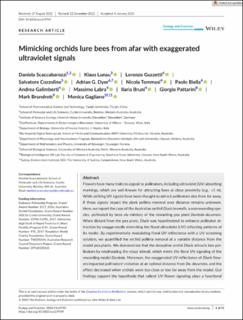| dc.contributor.author | Scaccabarozzi, Daniela | |
| dc.contributor.author | Lunau, Klaus | |
| dc.contributor.author | Guzzetti, Lorenzo | |
| dc.contributor.author | Cozzolino, Salvatore | |
| dc.contributor.author | Dyer, Adrian G. | |
| dc.contributor.author | Tommasi, Nicola | |
| dc.contributor.author | Biella, Paolo | |
| dc.contributor.author | Galimberti, Andrea | |
| dc.contributor.author | Labra, Massimo | |
| dc.contributor.author | Bruni, Ilaria | |
| dc.contributor.author | Pattarini, Giorgio | |
| dc.contributor.author | Brundrett, Mark | |
| dc.contributor.author | Gagliano, Monica | |
| dc.date.accessioned | 2023-10-18T09:17:29Z | |
| dc.date.available | 2023-10-18T09:17:29Z | |
| dc.date.created | 2023-02-18T18:37:33Z | |
| dc.date.issued | 2023-01 | |
| dc.identifier.citation | Scaccabarozzi, D., Lunau, K., Guzzetti, L., Cozzolino, S., Dyer, A.G., Tommasi, N., Biella, P., Galimberti, A., Labra, M., Bruni, I., Pattarini, G., Brundrett, M. & Gagliano, M. (2023) Mimicking orchids lure bees from afar with exaggerated ultraviolet signals. Ecology and Evolution, 13 (1). | en_US |
| dc.identifier.issn | 2045-7758 | |
| dc.identifier.uri | https://hdl.handle.net/11250/3097219 | |
| dc.description.abstract | Flowers have many traits to appeal to pollinators, including ultraviolet (UV) absorbing markings, which are well-known for attracting bees at close proximity (e.g., <1 m). While striking UV signals have been thought to attract pollinators also from far away, if these signals impact the plant pollinia removal over distance remains unknown. Here, we report the case of the Australian orchid Diuris brumalis, a nonrewarding species, pollinated by bees via mimicry of the rewarding pea plant Daviesia decurrens. When distant from the pea plant, Diuris was hypothesized to enhance pollinator attraction by exaggeratedly mimicking the floral ultraviolet (UV) reflecting patterns of its model. By experimentally modulating floral UV reflectance with a UV screening solution, we quantified the orchid pollinia removal at a variable distance from the model pea plants. We demonstrate that the deceptive orchid Diuris attracts bee pollinators by emphasizing the visual stimuli, which mimic the floral UV signaling of the rewarding model Daviesia. Moreover, the exaggerated UV reflectance of Diuris flowers impacted pollinators' visitation at an optimal distance from Da. decurrens, and the effect decreased when orchids were too close or too far away from the model. Our findings support the hypothesis that salient UV flower signaling plays a functional role in visual floral mimicry, likely exploiting perceptual gaps in bee neural coding, and mediates the plant pollinia removal at much greater spatial scales than previously expected. The ruse works most effectively at an optimal distance of several meters revealing the importance of salient visual stimuli when mimicry is imperfect. | en_US |
| dc.language.iso | eng | en_US |
| dc.publisher | John Wiley & Sons. | en_US |
| dc.rights | Navngivelse 4.0 Internasjonal | * |
| dc.rights.uri | http://creativecommons.org/licenses/by/4.0/deed.no | * |
| dc.subject | pollinering | en_US |
| dc.subject | bier | en_US |
| dc.title | Mimicking orchids lure bees from afar with exaggerated ultraviolet signals | en_US |
| dc.type | Peer reviewed | en_US |
| dc.type | Journal article | en_US |
| dc.description.version | publishedVersion | en_US |
| dc.rights.holder | © 2023 The Authors | en_US |
| dc.subject.nsi | VDP::Matematikk og Naturvitenskap: 400::Basale biofag: 470 | en_US |
| dc.source.pagenumber | 0 | en_US |
| dc.source.volume | 13 | en_US |
| dc.source.journal | Ecology and Evolution | en_US |
| dc.source.issue | 1 | en_US |
| dc.identifier.doi | 10.1002/ece3.9759 | |
| dc.identifier.cristin | 2127224 | |
| cristin.ispublished | true | |
| cristin.fulltext | original | |
| cristin.qualitycode | 1 | |

